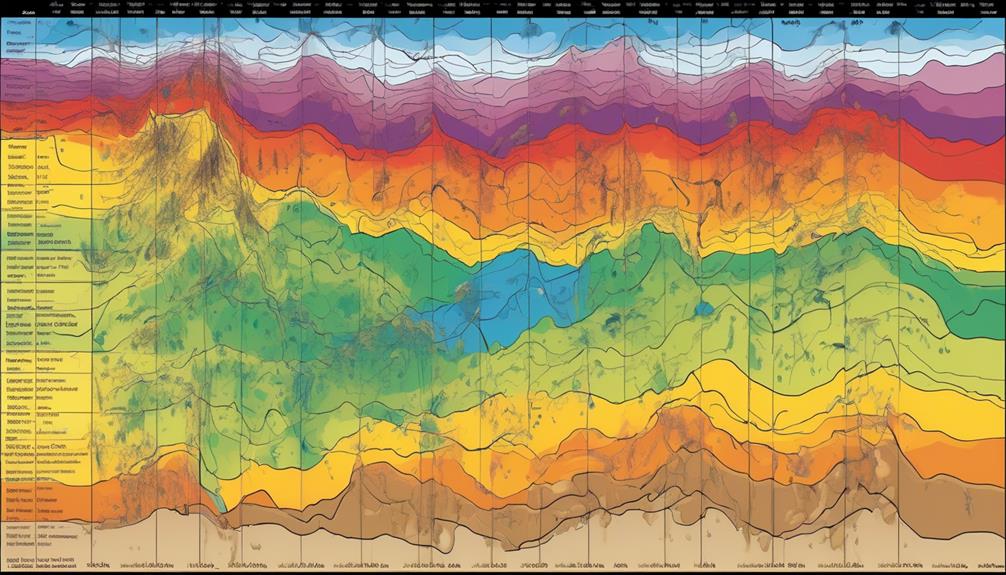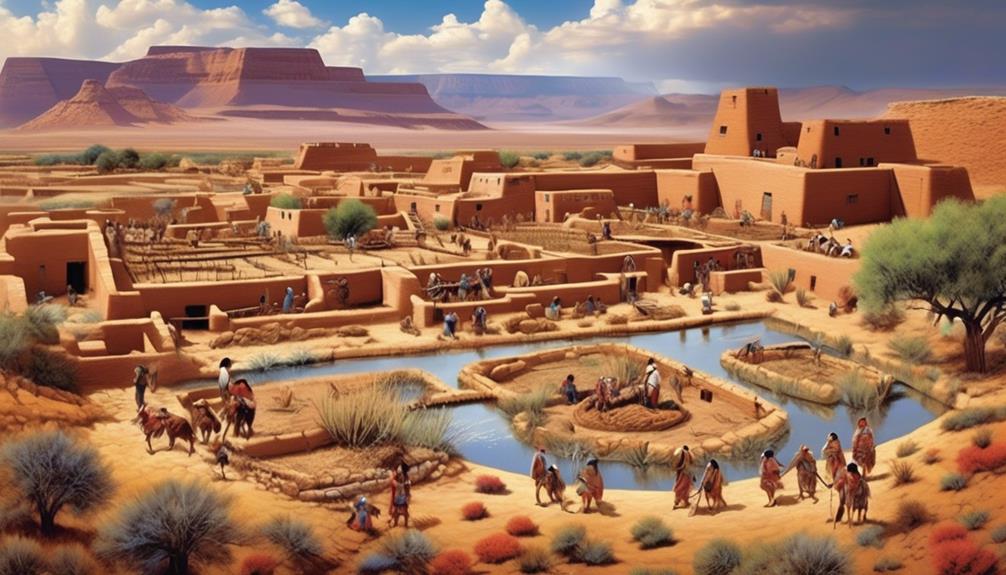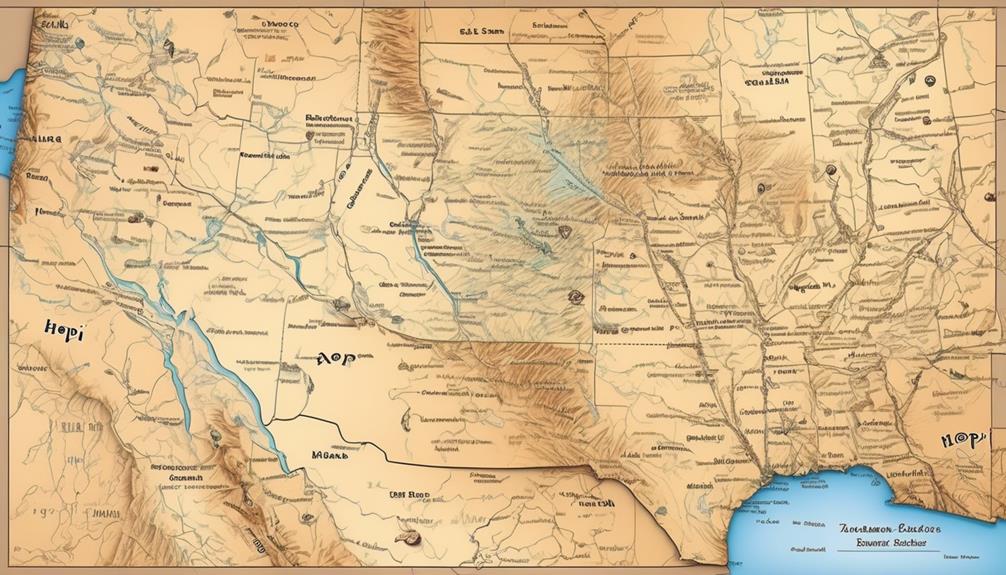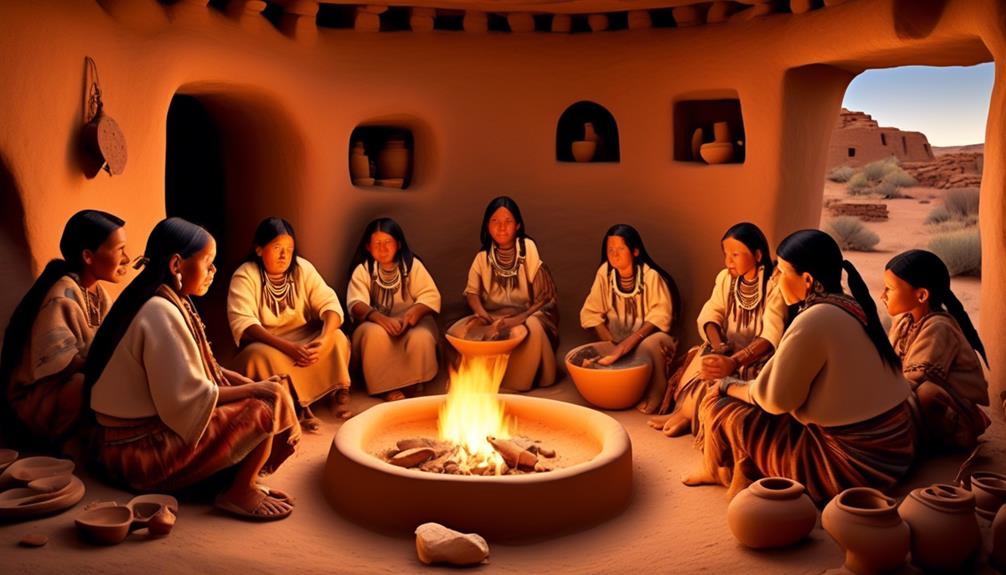Looking back at history, we feel compelled to explore the enigmatic climate that surrounded the ancient Hopi tribe.
Nestled within the arid expanse of the American Southwest, the Hopi people were intimately intertwined with the capricious elements that shaped their existence.
But what were the specific climatic conditions that dictated their daily lives and agricultural practices?
Join us as we uncover the intricate nuances of the climate that both sustained and challenged the Hopi tribe, shedding light on their resilience in the face of environmental adversity.
Key Takeaways
- The Hopi Tribe is located in northeastern Arizona and faces challenges such as an arid climate and limited natural resources like water and fertile soil.
- The Hopi people have developed unique cultural practices, including sophisticated irrigation techniques and a cultural value for water conservation, to sustain themselves in the face of low annual precipitation levels.
- The Hopi Tribe experiences extreme temperature differentials, with scorching hot summers and bitterly cold winters. The Hopi people have adapted their lifestyle and clothing to cope with these temperature extremes.
- Seasonal variations deeply influence the Hopi Tribe's traditional practices, cultural ceremonies, and agricultural practices. The timing of planting and harvesting is dictated by seasonal changes, and each season holds spiritual significance for the Hopi people. Agriculture plays a central role in preserving the cultural heritage of the Hopi Tribe.
Geographic Location
Located in the northeastern region of Arizona, the Hopi Tribe's geographic location encompasses an area of approximately 2,500 square miles. This land is characterized by its arid climate, with limited natural resources such as water and fertile soil. Despite these challenges, the Hopi people have developed unique cultural practices that have sustained them for centuries.
The scarcity of natural resources has greatly influenced the Hopi way of life. Water, in particular, is a precious commodity, and the tribe has developed intricate systems for collecting and conserving it. Agriculture is a fundamental aspect of Hopi culture, and the people have adapted to the arid environment by practicing dry farming and utilizing traditional irrigation methods.
Cultural practices such as ceremonies, dances, and rituals are deeply rooted in the Hopi way of life and are closely tied to the land. The tribe's connection to the natural world is evident in their reverence for the earth and their sustainable use of resources. Through their cultural practices, the Hopi have maintained a harmonious relationship with the land, demonstrating resilience and adaptability in the face of environmental challenges.
Annual Precipitation Patterns

The Hopi Tribe experiences minimal annual precipitation, which profoundly impacts their traditional agricultural practices and way of life. This arid climate has shaped the environmental adaptations and cultural practices of the Hopi people for centuries.
- Challenges in Agriculture: The low annual precipitation levels present significant challenges for farming and sustaining crops, leading the Hopi to develop sophisticated irrigation techniques and drought-resistant crop varieties.
- Water Conservation: The scarcity of rainfall has fostered a deep cultural value for water conservation. The Hopi have traditionally employed terracing, cisterns, and other water-harvesting methods to maximize the use of limited water resources.
- Cultural Significance: Annual precipitation patterns are deeply intertwined with Hopi spirituality and ceremonies. Rain dances and rituals are performed to seek the blessing of moisture for the land and crops.
- Adaptation and Resilience: Despite the challenges posed by minimal rainfall, the Hopi people have demonstrated remarkable resilience and ingenuity in adapting to their arid climate, exemplifying a harmonious relationship with the natural environment.
Understanding the annual precipitation patterns is crucial for appreciating the environmental and cultural dynamics that have shaped the Hopi Tribe's way of life.
Temperature Extremes
Experiencing temperature extremes, the Hopi Tribe navigates the challenges and opportunities presented by the fluctuating climate in their traditional territory.
The region they inhabit is characterized by scorching hot summers and bitterly cold winters, with temperature differentials often exceeding 40 degrees Fahrenheit in a single day.
In response to these extreme temperatures, the Hopi people have developed a deep understanding of their environment and have adapted their lifestyle and traditional clothing to cope with these fluctuations.
During the harsh winters, the Hopi wear layers of blankets and woven garments to provide insulation and protection from the biting cold. Conversely, in the sweltering heat of summer, their loose-fitting, lightweight cotton garments allow for ventilation and aid in keeping the body cool.
This intricate knowledge of how to dress according to the temperature extremes is a testament to the Hopi Tribe's resilience and their harmonious relationship with the natural world.
Despite the challenges posed by the extreme temperatures, the Hopi have embraced the opportunities to showcase their rich cultural heritage through their traditional clothing, which not only serves a functional purpose but also holds deep spiritual and symbolic significance within their community.
Seasonal Variations

How do the seasonal variations impact the traditional practices and cultural ceremonies of the Hopi Tribe in their ancestral lands?
Seasonal changes play a vital role in the traditional way of life for the Hopi Tribe. The cycle of the seasons influences various aspects of their cultural ceremonies, agricultural practices, and spiritual beliefs.
- Planting and Harvesting: The seasonal variations dictate the timing of planting and harvesting for the Hopi Tribe. Traditional ceremonies are often tied to these agricultural activities, symbolizing the connection between the people and the earth.
- Ceremonial Calendar: Seasonal changes mark the beginning and end of specific ceremonial periods for the Hopi Tribe. These ceremonies are deeply rooted in the natural rhythms of the earth and are essential for maintaining cultural traditions.
- Spiritual Significance: Each season holds spiritual significance for the Hopi Tribe, influencing the themes and rituals of their traditional ceremonies. The changing of the seasons is intricately woven into their spiritual beliefs and practices.
- Connection to Nature: Seasonal variations serve as a reminder of the intimate connection the Hopi people have with the natural world. Traditional ceremonies often reflect this deep reverence for the changing seasons and the earth's cycles.
Impact on Agriculture
Seasonal variations significantly impact the agricultural practices of the Hopi Tribe, shaping the timing and significance of planting, harvesting, and traditional ceremonies that are intricately intertwined with the earth's natural rhythms. The Hopi people have developed unique agricultural practices that are closely attuned to the climate and natural resources of their arid environment. The planting and harvesting times are determined by the seasonal changes, ensuring that the crops receive the optimal conditions for growth. Traditional ceremonies, such as the Hopi Snake Dance, are also tied to agricultural practices, seeking blessings for successful harvests. This deep connection between agriculture and cultural ceremonies reflects the reverence and gratitude the Hopi people have for the land and its bounties.
Agricultural practices aren't only essential for sustenance but also play a central role in preserving the cultural heritage of the Hopi Tribe. Food security is intrinsically linked to the success of their agricultural endeavors. The reliance on traditional farming methods and the preservation of heirloom seeds are vital for maintaining food security and preserving the cultural identity of the Hopi people. Despite the challenges posed by the climate, the Hopi Tribe's agricultural practices continue to be a testament to their resilience and deep-rooted connection to the land.
Frequently Asked Questions
How Did the Climate Affect the Hopi Tribe's Traditional Ceremonies and Rituals?
The climate significantly impacted the Hopi tribe's traditional ceremonies and rituals. Our connection to the environment is integral to our cultural practices, and the changing climate has forced us to adapt our rituals to ensure environmental sustainability.
The impact on rituals has led us to reevaluate and modify certain practices to align with the changing climate, allowing us to preserve our traditions while also respecting and protecting the natural world around us.
What Impact Did Climate Change Have on the Availability of Natural Resources for the Hopi Tribe?
Climate change had a significant impact on the availability of natural resources for the Hopi Tribe. As temperatures rose, water sources diminished, affecting crop yields and making it harder to sustain traditional agricultural practices.
Additionally, changes in precipitation patterns led to droughts, further limiting access to essential resources. These challenges forced our community to adapt and innovate to ensure the availability of vital natural resources for our people's well-being.
How Did the Hopi Tribe Adapt Their Clothing and Housing to the Climate?
We adapted our clothing to the climate by using cotton and weaving lightweight, breathable garments for the hot desert weather.
Our housing was modified to include thick adobe walls, small windows, and flat roofs to provide insulation and protection from the intense sun and occasional sandstorms.
These adaptations allowed us to stay cool in the scorching heat and endure the harsh conditions of our environment while preserving our cultural traditions.
Did the Climate Influence the Migration Patterns of the Hopi Tribe?
The migration patterns of the Hopi tribe were influenced by environmental factors such as water availability, soil fertility, and climate variations. These conditions shaped our movement and settlement decisions, as we sought out areas conducive to agriculture and sustainable living.
Our ancestors carefully observed the land, weather patterns, and natural resources, allowing us to thrive and adapt to the changing climate. This deep connection with the environment guided our migration patterns and sustained our cultural heritage.
What Role Did the Climate Play in the Development of the Hopi Tribe's Social and Cultural Practices?
The impact of weather on the development of the Hopi tribe's social and cultural practices is significant. The climate influenced our agricultural practices, shaping our beliefs and ceremonies.
The scarcity of water and arid conditions led to the creation of innovative farming techniques and a strong emphasis on water conservation. Our social structure and ceremonies are deeply rooted in our relationship with the land and the challenges posed by the climate.
Conclusion
In conclusion, the climate for the Hopi tribe was challenging but also integral to their way of life. The annual precipitation patterns and temperature extremes greatly impacted their agriculture, leading them to develop unique farming techniques such as dry farming and terraced fields.
For example, during a particularly dry year, the Hopi people relied on their knowledge of water conservation and crop rotation to ensure a successful harvest, demonstrating their resilience and adaptability in the face of environmental challenges.
Mary is a passionate writer who brings creativity and a fresh perspective to our team. Her words have the power to captivate and inspire, making her an essential contributor to our content. Mary’s commitment to storytelling and dedication to promoting Indigenous culture ensures that her work touches the hearts of our readers. We’re fortunate to have her as part of our team.










